The Microsoft Surface Pro 6 Review: More Than A Color
by Brett Howse on October 16, 2018 3:01 AM EST- Posted in
- Laptops
- Microsoft
- Surface
- Tablets
- Surface Pro
- Surface Pro 6
System Performance
As of late, Microsoft’s launch schedule for Surface doesn’t seem to coincide with the industry norms, and that continues with the Surface Pro 6. Surface Pro 4 and Surface Book were the launch devices for Intel’s latest Skylake processors, and power management issues with that series of SoC has likely made the Surface team a bit wary about being first out of the gate again. As such, the release cadence doesn’t fall in-line with the normal yearly update as with most OEMs.
So, it’s a bit delayed, but with the Surface Pro 6 we get our first Microsoft designed convertible tablet with the quad-core lineup of 8th generation Intel Core CPUs, which have generally made a pretty sizeable impact in terms of overall device performance compared to the outgoing Kaby Lake dual-core U series. Microsoft is offering the Surface Pro 6 with either the Core i5-8250U, or the Core i7-8650U, both of which are Kaby Lake Refresh. Intel has just recently launched their latest Whiskey Lake processors though, so once again we see Microsoft updating at the tail end of a generation. The good news this time is that there aren’t significant changes for Whiskey Lake, although the inclusion of hardware mitigations to the Spectre and Meltdown vulnerabilities would have been welcomed.
The maximum RAM is still the same 16 GB as seen for a while, and this limitation is due to the maximum RAM size of LPDDR3, which we still see in most low-power PCs. Intel hasn’t added LPDDR4 support to any of their lineup yet with the exception of their Gemini Lake Atom based CPUs.
Last year we were able to check out the Core i7-7660U model of Surface Pro, which offered Intel Iris graphics and 64 MB of eDRAM cache, but the Iris model is no longer available in the 15-Watt range, so for this year, at least for now, Microsoft has had to step back to the traditional UHD 620 graphics.
Starting with the 2017 Surface Pro, Microsoft removed the fan from the Core i5 model, and that has continued with the 2018 Surface Pro 6, so this is our first chance to check out a fanless Surface Pro as well.
To test system performance the Surface Pro 6 was run through our standard suite of laptop tests. If you’d like to compare its performance against any other device we have tested, please check out our Laptop Bench.
PCMark
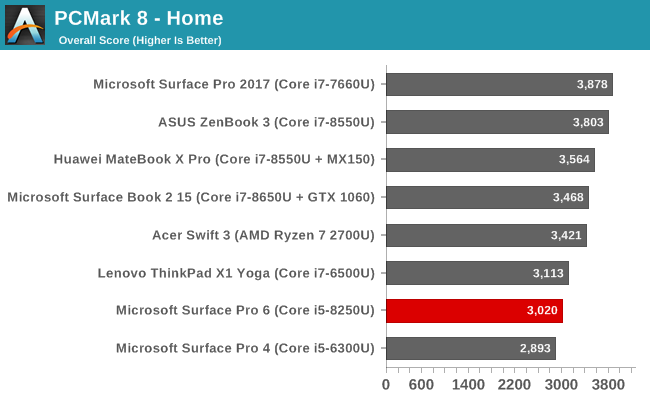
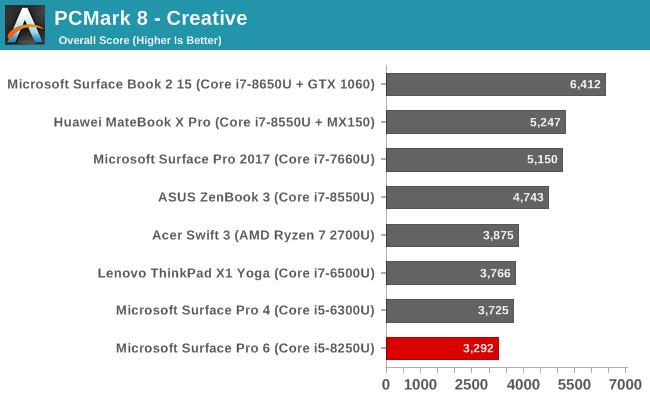
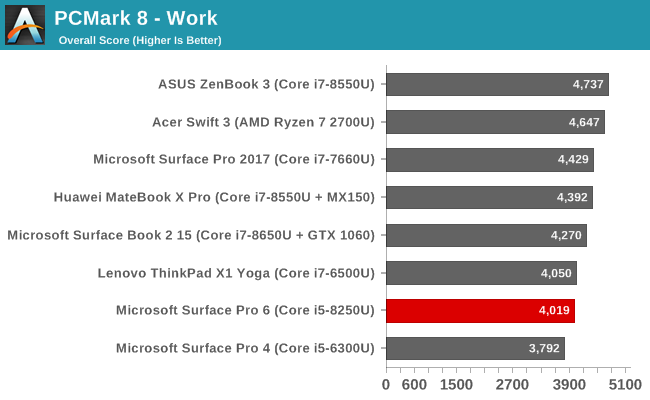
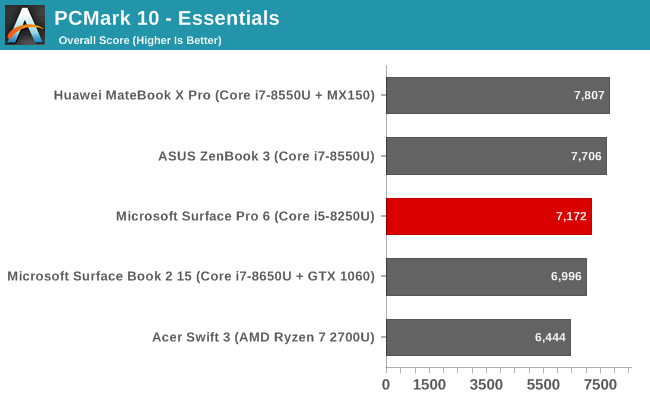
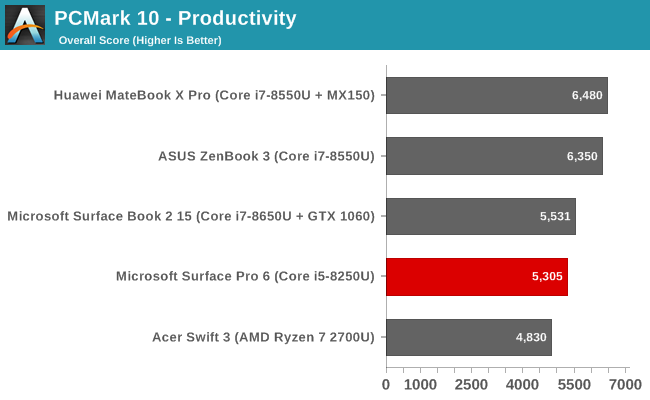
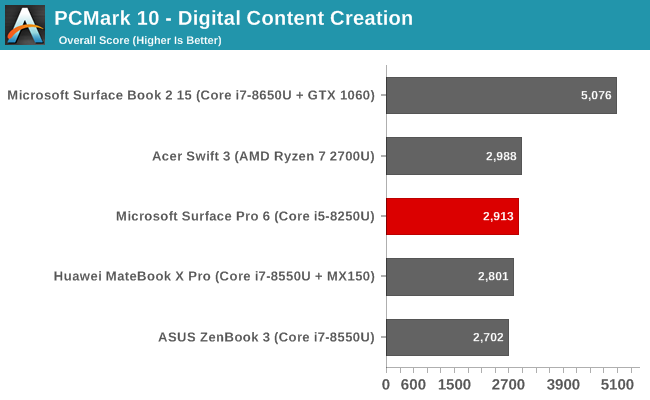
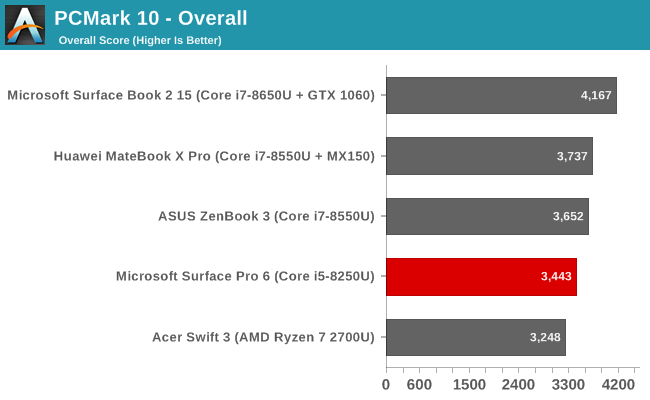
UL Benchmarks PCMark is a good tool to evaluate overall system performance, since it tests all aspects of the device. The Core i5 model can’t quite hang with the fastest Core i7 laptops around, but considering it’s the only laptop in the lineup that is passively cooled, it does remarkably well.
Cinebench
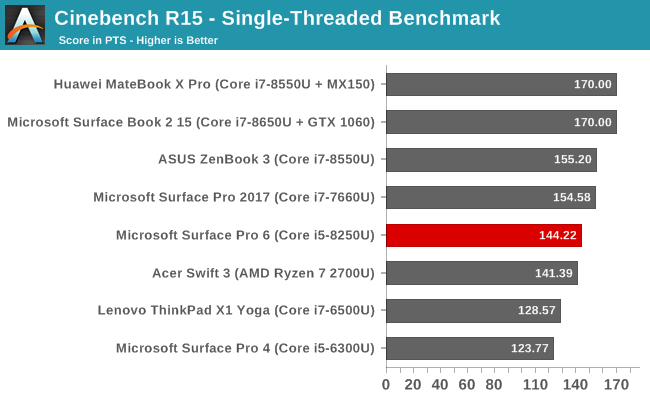
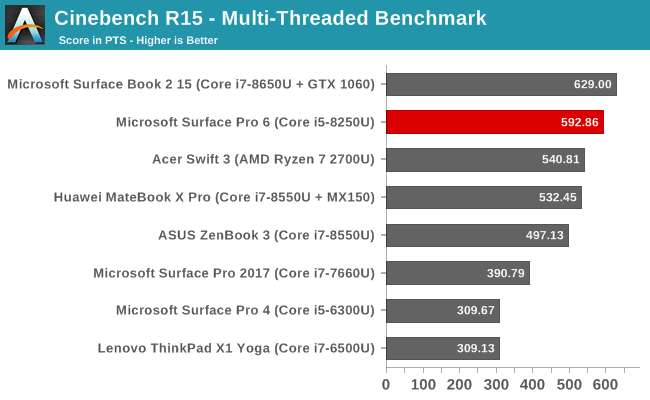
Cinebench R15 is purely CPU based test, and can be run in either single-threaded mode, or multi-threaded where more cores and higher turbo frequencies can really improve overall scores. In the single-threaded tests, the Core i5 in Surface Pro 6 is right in the middle of the pack, with it’s maximum boost frequency of just 3.4 GHz compared to a maximum boost of 4.2 GHz in a Core i7-8650U. But when you scale up the workload to multiple cores, the two extra cores and four extra threads in the Kaby Lake Refresh processor catapult it near the top, offering 66% more performance than the Core i7-7660U in last year’s Surface Pro.
x264
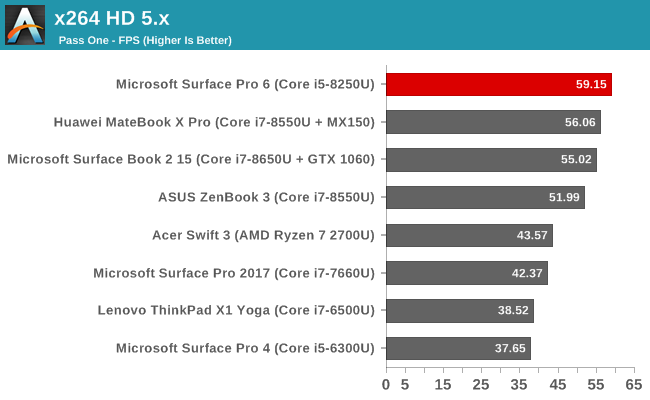
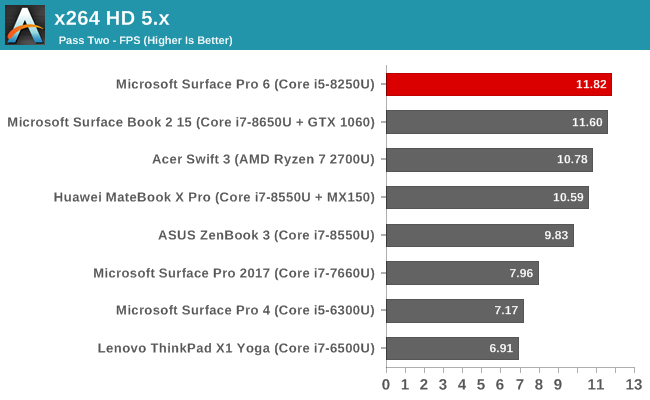
Another CPU test, x264 converts a video using the CPU, and generally scales well across more cores and threads, so the quad-core Surface Pro 6 does very well here, actually outperforming even the Core i7 in other devices. This is also quite a long test, meaning the Surface Pro 6 certainly would have run into its thermal limit, but it still offered excellent performance, meaning the passive cooling system was able to cope.
Web Tests
All of our web tests are run using the latest version of Microsoft Edge, and the Surface Pro 6 was tested on Windows 10 version 1803.
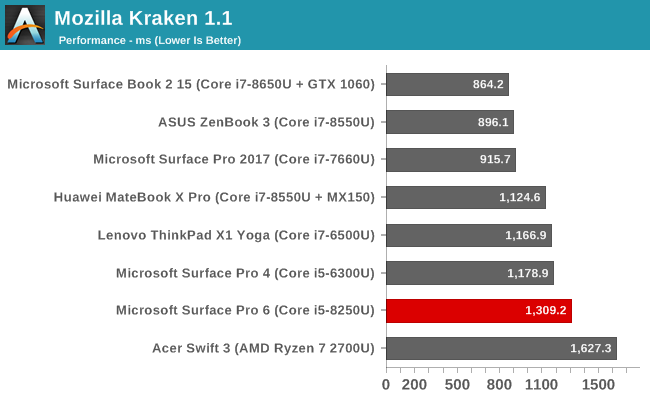
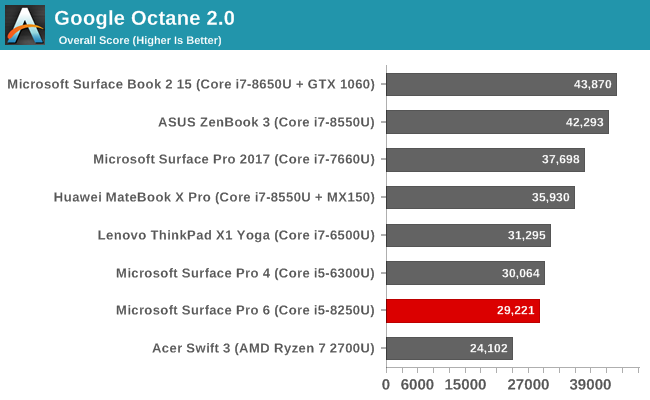
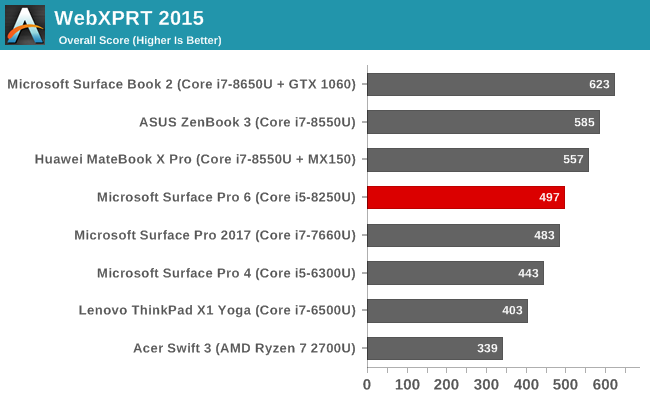
Here the Surface Pro 6’s Core i5 didn’t fare so well, with middling scores compared to the latest laptops around. Possibly due to the fanless nature, the PL2 values for the Surface Pro 6 were limited to around 23-Watts, and on other Kaby Lake Refresh devices, it’s not unusual to see 30-Watts for short bursts, and web tests tend to thrive on short bursts of performance.










80 Comments
View All Comments
cfenton - Monday, November 5, 2018 - link
This is just non-sense. I have a 5 year old Macbook Pro I use almost everyday and its battery is fine. I'm sure some will die in 3 years, but most will run just fine for much longer.star-affinity - Wednesday, October 17, 2018 - link
I think it looks great. Some aspects of Windows 10 looks pretty decent too. Too bad a lot of third party Windows software seems made by people who seemingly have little sense of graphic/user interface design an seems stuck with a Windows 95-ish look for their apps.Frenetic Pony - Wednesday, October 17, 2018 - link
"the display on the Surface Pro 6 is one of the best around, with accurate colors, high resolution, and now, even better contrast."The hell it is, the Ipad Pro has had a brighter, higher contrast, HDR display since last year AND has great battery life. My phone has a brighter, higher contrast, better calibrated, HDR display than this has. Lenovo has HDR screens on laptops that work fine, and have a higher PPI to boot. Microsoft is driving around competing for an entire division lower than "best tech possible" and charging a thousand+ dollars for it.
This entire device is pathetic, Whiskey Lake has a USB 3.1 controller built in but MS has deliberately downgraded it, probably just to make it's NEXT Surface seem like a better upgrade. Where's the Thunderboldt 3 ports MS? Intel dropped the licensing, even AMD laptops include it. Calling this device anything other than a deliberately crippled second tier device MS doesn't care about is a journalistic disservice.
Mitch89 - Wednesday, October 17, 2018 - link
"Other than Apple, Microsoft is the only company that controls both the hardware and software sides, and when the Surface lineup launched way back in 2012, Microsoft’s goal was to showcase the advantages of their platform with a premium hardware lineup. "I'm curious what things you think Microsoft have done to take advantage of this in 2018?
domboy - Friday, October 26, 2018 - link
Now if they'd just release a new ARM-based Surface with all these same improvements...c.economides - Saturday, October 27, 2018 - link
Can you please let us know which software you use to measure the thermal performance in this review?If it's proprietary are you able to share it with us?
Thank you.
c.economides - Saturday, October 27, 2018 - link
I am asking because my i5 Surface Pro 6 reproduces the results from all other benchmarks you have run on your test unit, but using prime95 or the powermax stress test, I absolutely havent to replicate your thermals.When all cores are testes (8 threads) the clock stabilizes at 2.4GHz and is a far way from the 2.9GHz you mention. The way I can replicate your results almost 1:1, is if I set the test to 2 threads, then I get a stable power draw of 18W with an average clock of 2.9GHz
albert89 - Saturday, November 10, 2018 - link
Would love to see the same laptop with AMD's APU pro series installed.I have no doubt they can more than match CPU & GPU output at a lower price.
Not that anyone is interested in high performance, low cost laptops these days.
dehwei - Monday, May 13, 2019 - link
When running the battery tests what was the brightness set to? (ie. 40%) It's hard for us to translate nits to windows brightness control. Also was the keyboard attached and was the video playback with audio? If so, what was the volume set to? I am trying to recreate the video playback test with my surface.qiechai - Friday, June 12, 2020 - link
I'm a digital artist . I have a Surface Pro and I use it for drawing in Illustrator and like it a lot! Definitely do not regret the purchase, it saves me hours in terms of workflow. but the pen experience is not as good as the professional drawing tablet . I have a XP-Pen Artist 24 Pro drawing tablet with screen 24" . The pressure on my XP-Pen Artist 24 Pro screen drawing tablet is lighter and smoother especially at the low end, giving better, more natural marks. The Surface is usable, but is a bit of a compromise compared to the Artist 24 Pro . If you are looking for the best pen experience go with the professional graphic tablet.